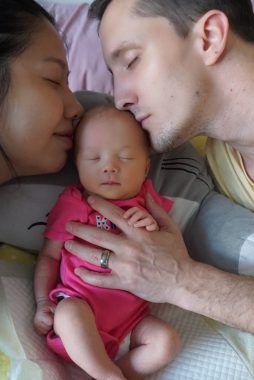Comforting Children With the Power of a Snuggle
Benefits of physical bonding help these parents ease their daughter's crises

Rylae-Ann was born by an emergency cesarean section. As Mom was stitched up and came off the anesthesia, I remained with a crying, screaming baby. As a new dad, I didn’t have a clue. I instinctively snuggled up to her and began to hum softly into her ear.
Three months later, we began to see what we called spells, and the doctors at the time thought they were seizures. We never thought they were seizures because we could briefly snap her out of it, and they would last several hours.
Later, after researching online, we learned they were oculogyric crises (OGCs), which are a common symptom of aromatic l-amino acid decarboxylase (AADC) deficiency. The events were made worse since they involved painful dystonic movements, when muscles contract involuntarily.
The end of each episode was announced with a wail when her body stopped contorting and she regained her typical floppy state. Later we learned a trick. If we could get her to sleep, we could end her OGC. Sleep was like medicine, a magic pill that could end her torture. This is where the intuitive snuggle technique came back.
Soothing snuggles
For your child, it may be a snuggle, an arm across the chest, or whispers in the ear. Finding that soothing energy that instinctively connects and bonds children with parents can help manage the severe symptoms of AADC deficiency.
We couldn’t minimize any of the symptoms of AADC deficiency except by resorting to sedating her, which we didn’t do. If we improved her sleep and prevented her from waking, her OGCs were not as intense or prolonged. If she was already experiencing an event, the snuggle helped her work through it until she eventually slept.

Judy and Richard snuggle with their newborn daughter, Rylae-Ann, in 2018. (Courtesy of Richard E. Poulin III)
Snuggles continue
Today, two years after gene therapy, we continue to snuggle with our daughter. It remains the trick to finally get her to go to bed and lie down. She noticeably calms down, her stress disappearing. Her energy level drops to a relaxed state.
A strong bonding experience happens at the beginning of life from snuggling with your child. I have to admit that I was one of those dads who read a self-help guide to parenting before my child was born. The book discussed the well-documented physical benefits of snuggling.
When my daughter came into this world, anything I’d ever read immediately went from my mind. All I knew was my body telling me to get close to her and stay there.
After a long week, we turn on a movie, and all benefit from a shared family snuggle.

In 2022, Rylae-Ann does the snuggling with her father. (Courtesy of Richard E. Poulin III)
Note: AADC News is strictly a news and information website about the disease. It does not provide medical advice, diagnosis, or treatment. This content is not intended to be a substitute for professional medical advice, diagnosis, or treatment. Always seek the advice of your physician or other qualified health provider with any questions you may have regarding a medical condition. Never disregard professional medical advice or delay in seeking it because of something you have read on this website. The opinions expressed in this column are not those of AADC News or its parent company, BioNews, and are intended to spark discussion about issues pertaining to aromatic l-amino acid decarboxylase deficiency.






Comments